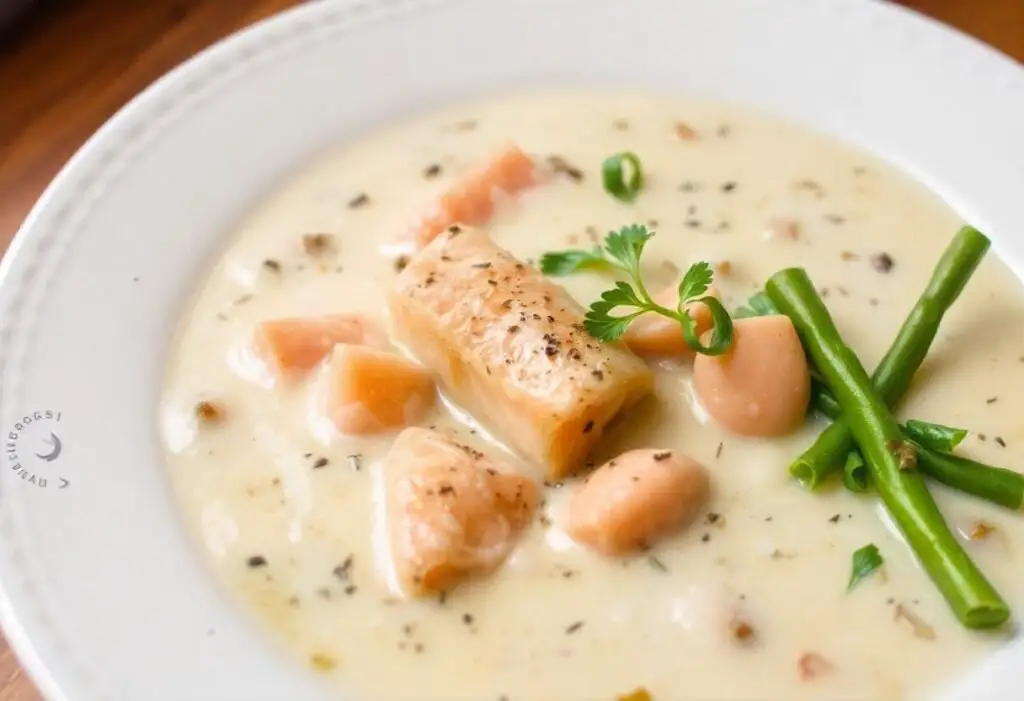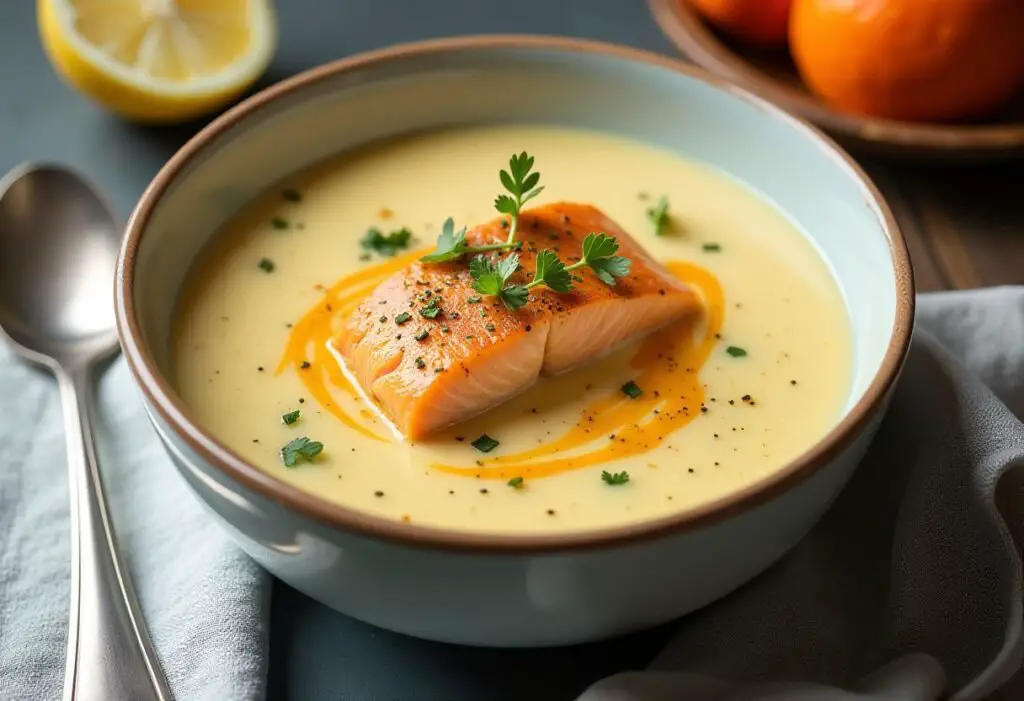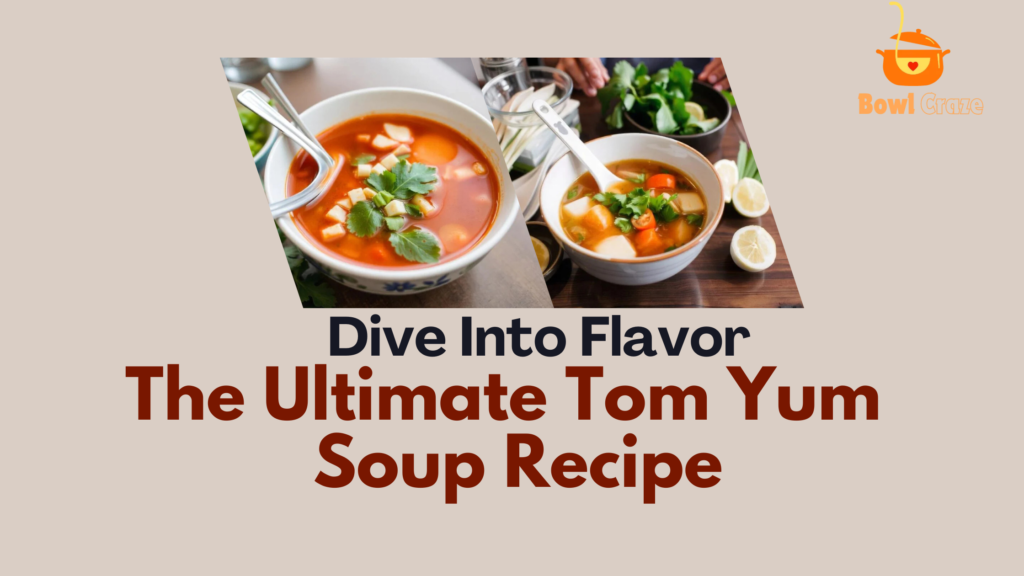Table of Contents
Introduction: The Comfort of Salmon Chowder

When the winds grow cold or if you are in the mood for comfort, nothing’s quite as cozy as a bowl of salmon chowder. This creamy delight featuring fresh salmon combined with hearty vegetables helps create a dish that not only is delightful in its taste but also stays within your nutritional bounds. A tasty part of this amazing salmon chowder besides filling that flavor, is nostalgic and reminds them of those family dinners and cozy gathering times. Now let’s delve into the rich history behind this oft-revised dish, make our way through a yummy recipe, and find out why your salmon chowder just has to find its place in your repertoire.
Historically, the origin of Chowder can be traced back to coastal communities that spent their entire existence fishing for fish. The term “chowder” is taken from the French term “chaudière,” referring to a cooking pot. Traditionally, everything a fisherman could catch was typically cooked together with other local ingredients and coaxed into a hearty stew in a communal pot. Today, there are countless varieties of chowder, but one of them is the salmon chowder which became a monumental success and revealed our superiority and the versatility of seafood.
Ingredients: What Makes the Perfect Salmon Chowder?
The secret ingredient to an amazing salmon chowder. Below is a rundown on exactly what you will need for the recipe:
Fresh Salmon: Choosing the Right Cut
And the star of it all: salmon. For the flavor, as well as texture, use fresh filets. Wild-caught is preferred because of the greater depth of flavor and more omega-3. But when wild-caught is completely out of the question, farmed salmon can be substituted in some pinch. Choose skinless filets. They just melt into chowder so well.
Essential Vegetables: Potatoes, Onions, and More
Serve the salmon over a medley of vegetables. Some are usual you’ll recognize: Potatoes:
- Potatoes: You’ll want to use Yukon Gold and Russet potatoes for this recipe since they’ll break down as cooked and help them turn into a creamy delight. Chop them so all are roughly the same size that way they’ll cook at nearly the same rate.
- Onions: Yellow onions add another dimension to the flavors, bringing a form of sweetness. Also, onions sauté translucent cook differently compared to other choices made.
- Celery and Carrots: The crunch of these vegetables and the flavor they add must be included. Chop finely so they cook thoroughly.
The Secret to Creaminess: Broth and Dairy Options
When it’s creamy, all that richness is both broth and dairy. Here’s your choice:
- Broth: A decent-quality fish or veggie broth is the great base here. Of course, homemade is best, but when you’re crunched for time, it’s also remarkably good bought in the store.
- Milk or half-and-half: You can make it rich, heavy, and creamy. If you want to make this even lighter, whole milk, or a non-dairy alternative, like coconut milk, will do.
Step-by-Step Guide: How to Make Delicious Salmon Chowder
Now that you have your ingredients prepared, the rest is in the hands of the pots and pans. It is now time to start by preparing this simply scrumptious mouth-watering salmon chowder through this step-by-step guide.
Prep Work: Chopping and Slicing for Success
Start by preparing all the ingredients. Cut the potatoes, onions, celery, and carrots into coarse small pieces. All these will cook well and bring the delight of their textures to the eating experience. Chop the salmon into small pieces, and peel off any skin and bones.
Cooking the Base: Sautéing Aromatics
Put one tablespoon of olive oil or butter in a big pot and get that slightly hot. Chop the onions, celery, and carrots. Sauté for about 5 minutes until the onions are translucent is a great step to layer flavor in your chowder.
Adding Salmon: Perfect Timing for Tender Fish
Add your diced potatoes and pour in your broth after the aromatics have fragranced. Bring to a boil then turn it back into a simmer. You should cook this for about 15 to 20 minutes when your potatoes are tender.
Then add the salmon. Fold it into cubed salmon and cook for another 5-7 minutes or until the fish is completely done through, flaking easily with a fork. Do not overcook it as the salmon turns out too dry and rubbery in this state.
Final Touches: Creaminess and Seasoning Adjustments
Simmer the chowder on low heat for about 5 minutes. Remove from heat. Add heavy cream or milk. Do not allow it to boil. Add a dash of salt, pepper, and fresh herbs of dill, and parsley, among others. Taste and season.
Check Out: Chill Out with Cold Cucumber Soup: The Ultimate Summer Refreshment.
Serving Suggestions: Elevate Your Salmon Chowder Experience

Your salmon chowder is now ready to be served. Here’s how you can serve and elaborate on your dining experience with the dish:
Tasty Accompaniments: Bread, Crackers, and Salads
- Bread: The bread will be fantastic to dip into and get a little wet with the creamy broth-so it needs to be sourdough, crusty, and warm. Serve with a chowder.
- Crackers: Add a bit of texture with buttery crackers or even oyster crackers.
- Salads: A light green salad along with a citrus vinaigrette will offer an interesting contrast to all of the richness of the chowder.
Garnishing Tips: Herbs and Spices to Impress
Top with fresh herbs, dill, or chives, which will give you more flavor and make your dish look presentable. In case you want to add more flair, you could drizzle some olive oil or sprinkle paprika.
Storage and Reheating: Keeping Your Salmon Chowder Fresh
Storage and Reheating: How to Store Fresh Salmon Chowder. If you end up making a lot and you have some leftovers, here is how you can store it and reheat the salmon chowder while ensuring that it does not lose its taste.
Best Practices for Refrigeration and Freezing
- Refrigeration: Refrigerate for 3 days with a covered bowl and maintain chills, without garnishing the chowder.
- Freezing: You can freeze the chowder, but if you thaw the cream texture can be changed. And if you’re freezing the chowder, then you should let the cream come to room temperature and add it upon reheating. For the refrigerator baking, wrap the baking and store it in a freezer-safe container and it can be kept in the refrigerator for 2-3 months.
How to Reheat Without Losing Flavor
To heat through, put the chowder in a pan over low heat and stir occasionally. Once you get the thickened chowder, add a splash of broth or milk to go for the consistency you want. Avoid boiling because the cream breaks.
Health Benefits of Salmon Chowder: More Than Just Delicious
Nutritional Value: Omega-3 Fatty Acids and More
A common type of fish, salmon, is also the best source of omega-3 fatty acids. Some fats, referred to as essential fatty acids, are good for the heart and brain. Some fats are good fats because they help reduce inflammation and hence their consumption has been compared with many studies to prevent chronic diseases. Salmon also contains high-quality proteins, vitamins B12 and D, and some minerals such as selenium.
Each of the vegetables that go into your chowder will give you fiber, vitamins, and minerals therefore; in a broad sense, you will be having a very balanced meal that will favor your health mostly.
Comfort Food with a Nutritional Boost
Fresh, healthy ingredients will make great use of this salmon chowder, which will not just be comfort food but good to eat. That would be so on cold nights or any time when someone needs something special to enjoy without losing that health aspect.
Conclusion: Savor the Flavor of Your Homemade Salmon Chowder
Having mastered salmon chowder, you now benefit from the efforts of ripeness for savoring. And what you have with you is a recipe that combines fresh and flavourful ingredients as well as serves to present a cozy experience to share with loved ones.
No matter if it’s a weeknight dinner or company’s coming, salmon chowder never fails to be devoured. Of course, feel free to fiddle with the recipe and make it your own; add spices, toss in some other vegetables, less creaminess, whatever you like.
For more details: Click Here.
FAQs
Can I use canned salmon instead of fresh?
Of course, you can even make it with canned salmon if you want to hurry the chowder up. You can just drain it well and add it in at the last few minutes of cooking.
How do I make my chowder thicker?
To thicken you can add a which is just a combination of flour and fat at the outset or take out part of the chowder, puree it, and then replace it in the pot. Otherwise, you can just add more potatoes to make the soup thicken naturally.
What can I substitute for cream?
For an even lighter version, you can replace heavy cream with full milk or half-and-half. And of course, you can even make it dairy-free with coconut milk or cashew cream.





